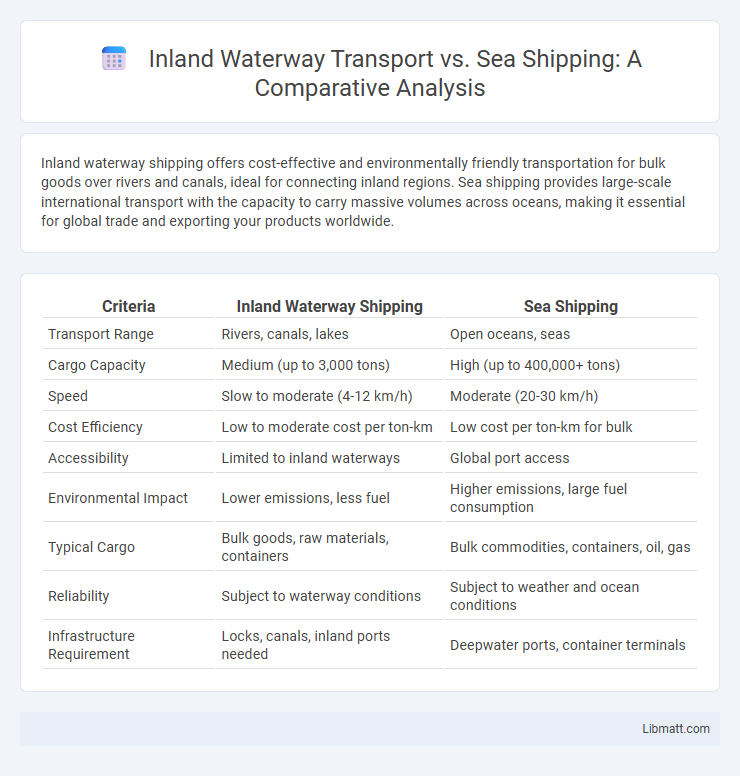Inland waterway shipping offers cost-effective and environmentally friendly transportation for bulk goods over rivers and canals, ideal for connecting inland regions. Sea shipping provides large-scale international transport with the capacity to carry massive volumes across oceans, making it essential for global trade and exporting your products worldwide.
Table of Comparison
| Criteria | Inland Waterway Shipping | Sea Shipping |
|---|---|---|
| Transport Range | Rivers, canals, lakes | Open oceans, seas |
| Cargo Capacity | Medium (up to 3,000 tons) | High (up to 400,000+ tons) |
| Speed | Slow to moderate (4-12 km/h) | Moderate (20-30 km/h) |
| Cost Efficiency | Low to moderate cost per ton-km | Low cost per ton-km for bulk |
| Accessibility | Limited to inland waterways | Global port access |
| Environmental Impact | Lower emissions, less fuel | Higher emissions, large fuel consumption |
| Typical Cargo | Bulk goods, raw materials, containers | Bulk commodities, containers, oil, gas |
| Reliability | Subject to waterway conditions | Subject to weather and ocean conditions |
| Infrastructure Requirement | Locks, canals, inland ports needed | Deepwater ports, container terminals |
Introduction to Inland Waterway and Sea Shipping
Inland waterway shipping utilizes rivers, canals, and lakes to transport goods, offering cost-effective and environmentally friendly solutions for bulk cargo over shorter distances. Sea shipping operates on vast oceanic routes, handling large volumes of international freight with extensive reach and economies of scale. Both modes play crucial roles in global logistics by complementing each other in multimodal transportation networks.
Key Differences Between Inland Waterway and Sea Shipping
Inland waterway shipping primarily involves transporting goods through rivers, canals, and lakes, offering cost-effective and environmentally friendly solutions for regional cargo movement. Sea shipping handles large-scale international freight across oceans, accommodating substantial cargo volumes with faster transit times for long distances. Your choice depends on factors like shipment size, destination, delivery speed, and cost efficiency, with inland waterways better suited for domestic or short-haul transport and sea shipping ideal for global trade.
Environmental Impact Comparison
Inland waterway shipping produces significantly lower greenhouse gas emissions per ton-mile compared to sea shipping due to reduced fuel consumption and more efficient vessel operation in calmer waters. The limited disturbance to marine ecosystems and decreased risk of oil spills further highlight inland waterways as a more environmentally sustainable freight option. While sea shipping facilitates global trade, its higher carbon footprint and potential for invasive species introduction pose substantial ecological challenges.
Cost Efficiency: Inland Waterway vs Sea Shipping
Inland waterway shipping offers superior cost efficiency for transporting bulk goods and heavy cargo over short to medium distances due to lower fuel consumption and reduced infrastructure expenses. Sea shipping, while typically more expensive per trip, benefits from economies of scale, making it cost-effective for long-haul international transport and large-volume shipments. Comparing operational costs, inland waterways provide a competitive alternative for regional freight movement, whereas sea shipping remains optimal for global trade and large container volumes.
Cargo Capacity and Types Handled
Inland waterways typically handle smaller cargo loads compared to sea shipping, with barges carrying up to a few thousand tons, ideal for bulk goods like coal, grain, and chemicals. Sea shipping vessels boast significantly larger cargo capacities, with container ships transporting tens of thousands of TEUs (twenty-foot equivalent units), making them suitable for diverse cargo types including electronics, automobiles, and heavy machinery. Understanding these differences helps optimize your logistics strategy based on cargo volume and type requirements.
Transit Time and Reliability
Inland waterway shipping generally offers more predictable transit times due to controlled routes and fewer weather disruptions compared to sea shipping, which is often affected by maritime conditions and port congestion. The reliability of inland waterways is enhanced by dedicated infrastructure and scheduled locks, minimizing delays and enabling consistent delivery schedules. Sea shipping, while capable of handling larger volumes over long distances, typically experiences greater variability in transit time, impacting supply chain dependability.
Infrastructure and Investment Requirements
Inland waterway shipping demands extensive investment in canals, locks, and dredging to ensure navigable routes, with costs influenced by geographic factors and water management needs. Sea shipping infrastructure requires significant capital for deepwater ports, container terminals, and specialized cargo handling equipment driven by international trade volume and vessel size. Both systems benefit from ongoing modernization efforts, but inland waterways often face higher maintenance to manage seasonal water level variations and sediment accumulation.
Regulatory and Safety Considerations
Inland waterway shipping is subject to regulations from authorities such as the U.S. Coast Guard and the European Commission, emphasizing vessel inspection, crew certification, and environmental standards specific to freshwater navigation. Sea shipping faces stringent international regulations governed by organizations like the International Maritime Organization (IMO), including adherence to SOLAS, MARPOL, and ISPS codes to ensure global safety and pollution control. Understanding these regulatory frameworks is crucial for your maritime operations to maintain compliance and optimize safety in both inland and sea shipping environments.
Geographical and Logistical Limitations
Inland waterway shipping is limited by the geographical constraints of rivers, canals, and lakes, often restricted by shallow depths, narrow channels, and seasonal variations like freezing or drought. Sea shipping offers broader geographical coverage, connecting global ports without the same depth or width constraints, but faces logistical challenges such as port capacity, weather disruptions, and longer transit times. Your choice depends on the specific route, cargo type, and infrastructure available at origin and destination points.
Future Trends in Waterborne Transportation
Future trends in waterborne transportation emphasize increased investment in inland waterways to reduce carbon emissions and alleviate port congestion compared to traditional sea shipping routes. Advancements in autonomous vessel technology and digital navigation systems are poised to enhance the efficiency and safety of both inland and maritime shipping operations. Your logistics strategy can benefit from integrating multimodal hubs that leverage inland waterway connectivity to optimize supply chains and minimize environmental impact.
inland waterway vs sea shipping Infographic

 libmatt.com
libmatt.com